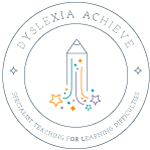Multi-sensory learning involves the use of two or more senses within an activity, to enhance memory and learning of written language. The teacher uses these senses to fully engage different parts of the student’s brain while learning fluency in spelling, reading and handwriting all at the same time.
What is Multi-Sensory Learning?
What sense does it involve?
-
Auditory (hearing and speaking through their ears)
-
Visual (seeing and perceiving through their eyes)
-
Tactile (through touch)
-
Kinaesthetic (movement, and doing through body movements)
How can it help with Dyslexia?
Whatever personal challenge you have to overcome, you must be brave enough to accept that you are different. You must have the courage to trust your instincts and be ready to question what other people don’t. If you do that, you can seize opportunities that others would miss. Believe in yourself, and use everything you can – including the obstacles – to propel you along the road to success. Who knows what you might achieve?
Richard Branson, ‘Turning a Disadvantage to Your Advantage’
There may be challenges but dyslexia can also come with gifts. Like Richard Branson a well-known business entrepreneur and dyslexic you to could make a difference. With specialist teaching and the right toolkit anyone can believe, succeed and shine.
Effective instruction for students with dyslexia needs to be explicit, direct, cumulative, intensive, and focused on the structure of language. Multi-sensory learning helps with all of these.
Quick Facts about Multi-Sensory Learning
- Different teaching methods activate different parts of the brain
- Helps learners discover their learning style and the techniques best for them
- Effective for dyslexic students
- Can be used in any subject from reading to maths to science and drama
- Works effectively for personalised learning
- Students with dyslexia often have challenges with language skills involving speech sound (phonological) and print (orthographic) processing and in building brain pathways that connect speech with print. The brain pathways used for reading and spelling must develop to connect many brain areas and must transmit information with sufficient speed and accuracy.
- Most students with dyslexia have weak phonemic awareness, meaning they are unaware of the role sounds play in words. These students may also have difficulty rhyming words, blending sounds to make words, or segmenting words into sounds. Dyslexic children and teens need specialised instruction to master the alphabetic code and to form those memories the multi-sensory approach allows the connection to take place in the brain and the development of necessary skills and strategies for the dyslexic. Through this approach they can learn to spell, read, write and improve their mathematics..!
- If a student learns something using more than one sense, the information is more likely to stay with him.
- Multi-sensory learning can be particularly helpful for kids with learning sensory and attention issues. For example, these kids may have trouble with visual or auditory processing. That can make it hard for them to learn information through only reading or listening. Multi-sensory instruction can help kids learn information more effectively. All kids can benefit from multi-sensory instruction.

